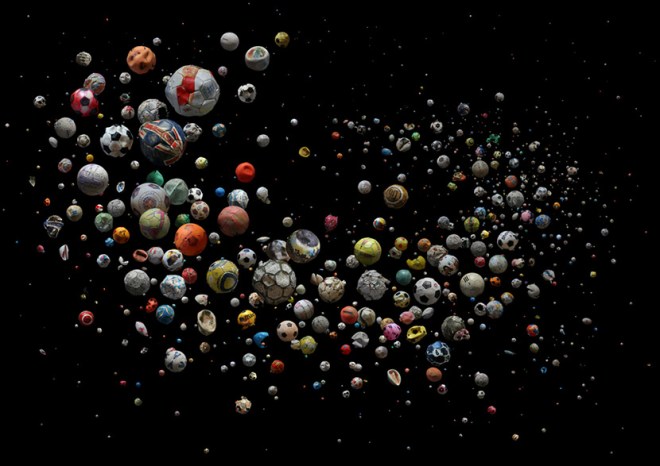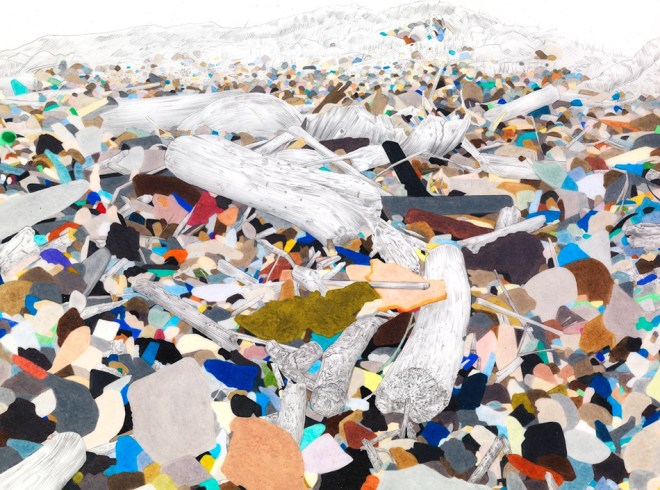The things we are doing to our ocean by and large ain’t pretty. From “plastic soup” to dead albatross babies, we’re stomping through the wild places of the world, leaving a trail of destruction and some really trashy driftwood. But a whole lot of ugly didn’t stop these four artists from making some top-notch art from actual junk. We could call it upcycled … but that would be sugarcoating a massive global problem. Instead, these artists are taking up the tools at hand to make pictures that are worth a thousand words — or a thousand plastic soccer balls, bottlecaps, and assorted gewgaws, as the case may be. Take a look:
Artist: Mandy Barker

All images © Mandy Barker.
Mandy Barker makes photographic murals that make the I Spy franchise look minimalist in comparison. These images are from a collection she calls SOUP, which is the name given to plastic debris suspended in the ocean. All the plastic objects photographed were salvaged from beaches around the world. As much as “plastic soup” may make you want to gag, Barker’s mission is to make aesthetically pleasing images out of discarded junk. After all, all that plastic came from something someone once found valuable.
Above: Soup: 500+ is made from more than 500 bits of plastic debris found in the digestive tract of a (dead) albatross chick in the North Pacific Gyre (aka the Great Garbage Patch).

Above: Penalty, from the Penalty collection, is made up of 597 washed-up soccer balls. Finding so many flotsam toy soccer balls took the artist and 47 members of the public a whole four months. These ones were collected from 87 different beaches on four countries and seven islands around the United Kingdom.

Above, Soup: Refused. These plastic objects have all been chewed at some point during their time at sea, presumably not by humans.
Artist: Chris Jordan

All images © Chris Jordan.
On Midway Atoll, a remote cluster of islands more than 2,000 miles from the nearest continent, global detritus ends up in the stomachs of thousands of baby albatrosses. The nesting chicks are fed lethal quantities of plastic by their parents, who mistake the floating trash for food as they forage over the vast Pacific Ocean. Nothing was added or moved in these documentary photographs; the pieces of plastic simply became visible as the birds decayed.

The artist writes: “For me, kneeling over their carcasses is like looking into a macabre mirror. These birds reflect back an appallingly emblematic result of the collective trance of our consumerism and runaway industrial growth. Like the albatross, we first-world humans find ourselves lacking the ability to discern anymore what is nourishing from what is toxic to our lives and our spirits.”
Artist: Aurora Robson

Above: Kamilo, 2011. Suspended sculpture, approximately 4′ x 3′ x 4 1/2′, 100% plastic marine debris from Kamilo Point, Hawaii. Photo by Marshall Coles.
Aurora Robson builds all her sculptures from plastic debris before it is recycled or discarded to make its way to sea. Scientists studying the problem of marine plastic all agree that the best thing we can do is cut plastic off at the source rather than clean it up once it’s already in the oceans. Robinson aims to do that with her art, and helps other artists do the same.

Above: Vortexas, 2008. Suspended sculpture, approximately 3′ x 2′ x 1′, plastic debris (PET), rivets + tinted polycrylic. Photo by Marshall Coles.
Robson founded an international collective of likeminded artists, designers, and architects called Project Vortex. She is also working on the development of a college course called “Sculpture and Intercepting the Waste Stream,” designed to raise money for shoreline clean-up organizations and give graduate students an opportunity to be catalysts in the expansion of stewardship.

Above: Goldrush, 2010. Suspended sculpture, approximately 2′ x 4′ x 3′, plastic debris (PET), rivets, tinted polycrylic, and mica powder. Photo by Marshall Coles.
Artist: Evelyn Rydz

Images © Evelyn Rydz.
Evelyn Rydz works verrrry slowly. This six-foot drawing, Oceanfront, took about 9 months to complete. She draws from the photographs taken on site (this one is of Kamilo Beach, Hawaii). By leaving the natural elements as the original pencil sketch, Rydz indicates the site’s history as a driftwood beach. This coast used to be covered with logs washed ashore from forests thousands of miles away. Rydz contrasts this ghostly history with the saturated, mostly plastic field of marine debris in the foreground.
Above: Oceanfront, 72” x 20” pencil and color pencil on Duralar, 2014. Below: 9” x 6” detail.

Rydz also drew a series of postcards, expanding certain details from the same beach in Hawaii. Below: Postcards from Kamilo (Bits and Pieces): 6” x 9”, pencil and color pencil on Duralar, 2013-2014.

Not choking on ocean plastics yet? Here are eight more things you should know.




